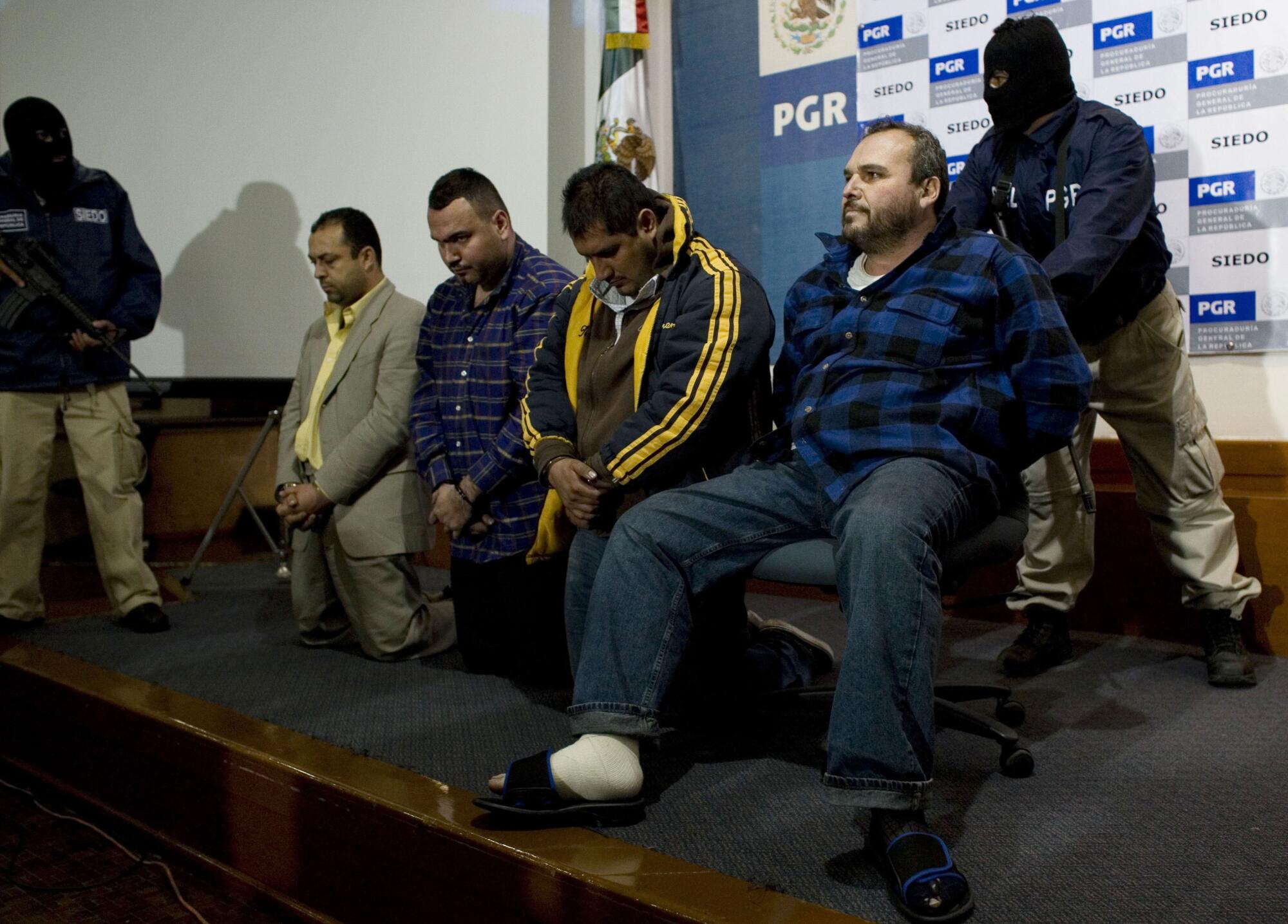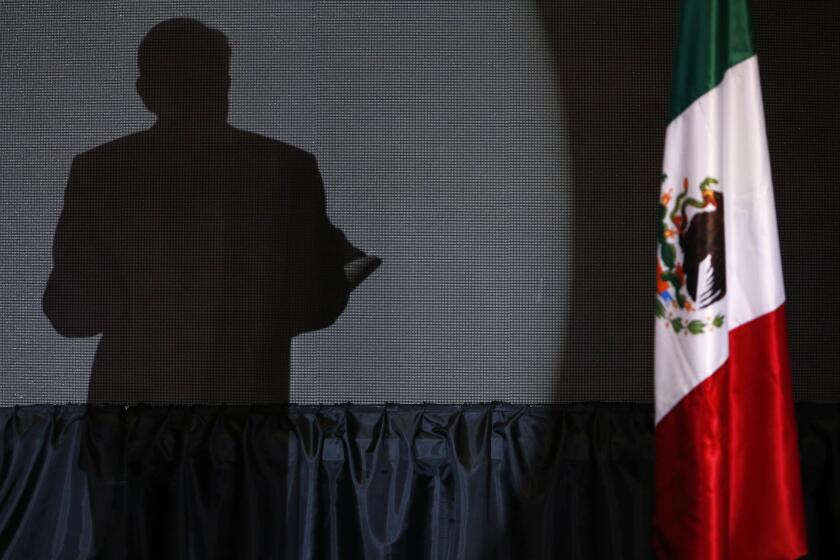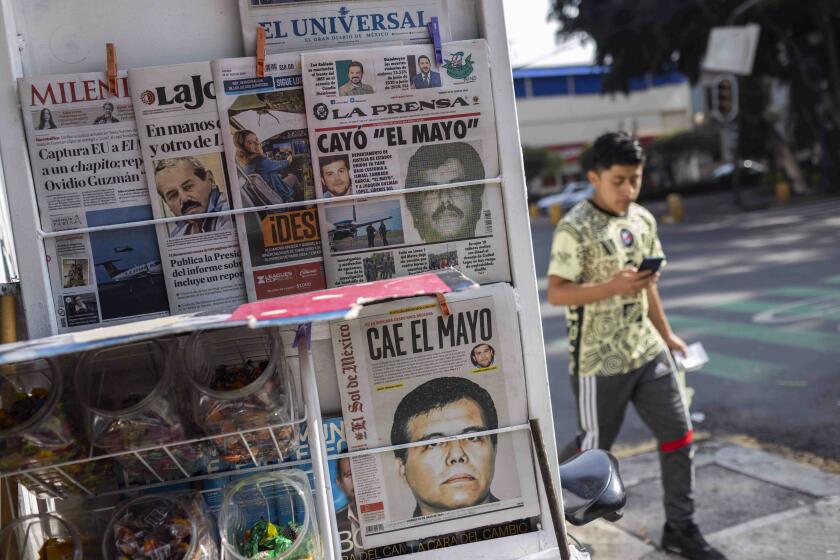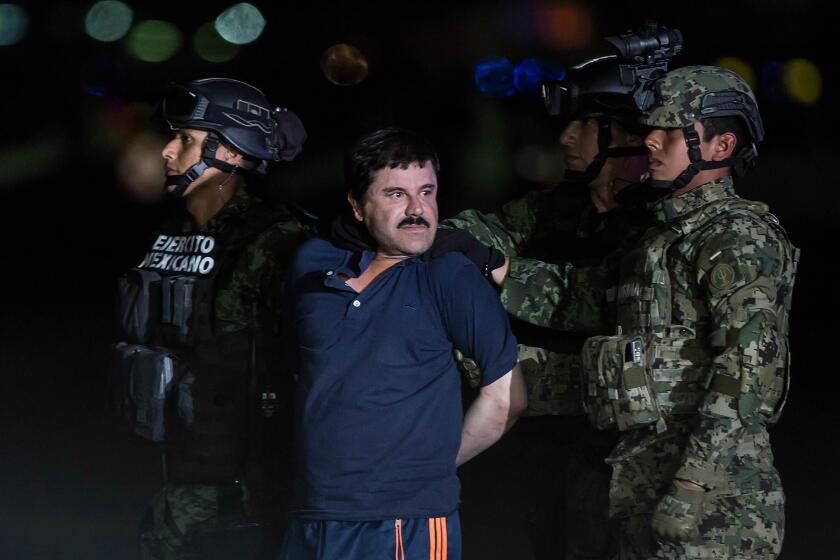
- Share via
CULIACÁN, Mexico — In this city built from the spoils of Mexico’s richest drug-trafficking empire, they’re calling it the “narco-pandemia’’ — not a virus but a deadly reckoning inside the Sinaloa cartel that has left businesses shuttered, schools empty and the streets nearly deserted.
Even the glitzy bars, exclusive car dealerships and plastic surgery boutiques catering to cartel lieutenants and their entourages are mostly closed.
Driving around after dark is a lonesome experience, the eerie consequence of what many label a “voluntary” curfew.
“Right now, there’s a psychosis everywhere in Culiacán,” said Donaciano García, a trumpet player and leader of a band desperate for work since cantinas and dance halls have shut down. “Things are terrible. No one wants to leave their home. It’s worse than the pandemic.”
More than 140 people have been killed in the last month, many of their bodies dumped on the streets.

Behind the chaos are two rival factions of the Sinaloa cartel. One is loyal to Ismael “El Mayo” Zambada, the 76-year-old cartel co-founder who was recently captured in the United States after what he calls his kidnapping in Culiacán. The other pledges allegiance to los chapitos, the sons of Joaquín “El Chapo” Guzmán, Zambada’s ex-partner, now serving a life term in the United States.
Mexican officials are demanding answers from investigators in the case of a politician whose killing appears tied to the capture of Ismael ‘El Mayo’ Zambada.
Both sides can call on thousands of heavily armed gunmen. In a warning last month against travel to Sinaloa, the U.S. government cited “car thefts, gunfire, security forces operations, roadblocks, burning vehicles and closed roadways.”
“We are not calling it a war — not yet anyway,” said Ismael Bojórquez, editor of the weekly Riodoce, whose co-founder Javier Valdez was assassinated in 2017 — a killing linked to his intrepid coverage. “But no one knows to where this is going to lead.”
On Sept. 29, hundreds of demonstrators emerged from their homes for a few hours to march through downtown behind a banner vowing: “We will reclaim our streets!”
Each day brings new shootouts and killings.

“I was cooking at the stove in my apartment when I heard the shots,” said Waldina Quintero, a house cleaner whose apartment complex in the Tres Ríos district became a battle zone on Sept. 21, when police cornered suspects there.
Quintero hid for two hours in a closet, listening to gunshots and what sounded like bombs — possibly grenades or tear-gas canisters.
Finally, she emerged to a battlefield vision: coils of smoke, blood-streaked stairs and blackened walls gouged with scores of bullets.
“I just feel lucky to be alive,” Quintero said. “It’s like I was born again.”
Her neighbor Juan Carlos Sánchez was one of three men shot dead at the scene. His family said the city employee, 34, was an innocent man who was slain as he tried to evacuate his wife and 8-month-old daughter, both of whom survived.
Authorities did not release details but said that Sánchez may have been a “collateral” victim.

: :
Until the 1980s, the state of Sinaloa was best known for its agriculture and seafood industries, along with the signature beach resort city of Mazatlán.
Then a crackdown by U.S. and Mexican authorities broke up what had long been the country’s biggest criminal organization — the Guadalajara cartel — and El Chapo and El Mayo ended up in control of Sinaloa’s marijuana and heroin trade.
The cartel they created soon pioneered connections with Colombian mobs to move cocaine to the United States, eventually expanding into methamphetamine and fentanyl, the synthetic opioid blamed for tens of thousands of U.S. deaths.
Sinaloa became the epicenter of Mexico’s multibillion-dollar drug-trafficking business, now a global enterprise.
Many of the profits wound up in the state capital of Culiacán, a city of a million where gangsters have enjoyed a certain respect for their contributions to the economy, public works and charities — and for tamping down on common street crime.
At the Jardines de Humaya cemetery, final resting place of many racketeers and their families, multi-story mausoleums feature balconies, air conditioning and ornate chapels.
While the drug business runs smoothest when there is peace, occasional spasms of deadly violence from cartel infighting have long been a way of life here — earning the city a treacherous reputation.
“So what do you eat in Sinaloa — besides bullets?” a restaurant owner, Miguel Taniyama, said he was once asked on a trip elsewhere in Mexico.
“We have become a society profoundly perverted by narco money,” he said the other day. “We are paying the price of decades of living with the culture of los narcos.”

The latest battle for power inside the cartel took a startling turn on July 25. That afternoon, a private, twin-engine plane landed in a rural airport outside El Paso, ferrying Zambada and his godson, Joaquín Guzmán López, a leader of los chapitos. U.S. authorities quickly arrested both.
Despite more than four decades on the run as one of the world’s most wanted fugitives, Mexican drug kingpin Ismael “El Mayo” Zambada had never spent a single night in jail -- until now.
In a letter distributed by his lawyer, Zambada said his godson’s goons kidnapped him at a resort in suburban Culiacán, tied him up, bundled him into the bed of a pickup, drove him to an airstrip and forced him on the plane.
On the day of the alleged kidnapping, former Culiacán Mayor Héctor Melesio Cuén — said to have been close to Zambada — was shot dead in a still-mysterious slaying that Zambada linked to his abduction.
For the next several weeks, as cartel bosses apparently figured out what to do, life seemed to go on as usual in Culiacán. Then on Sept. 9, nine people were found shot dead, bodies scattered on streets and roads. The killings have not abated.

In addition to the soaring number of homicides— the total last month almost tripled the September 2023 figure — civic groups have reported more than 100 people “disappeared.”
“Many more people are missing than what the government says,” said María Isabel Cruz, who heads a collective here searching for bodies.
Most of the dead remain anonymous, presumed foot soldiers of one side or the other in the bloodletting. Some were likely innocents caught in the crossfire.

In some cases, killers have sent messages to their rivals by adorning remains with cowboy hats — as Zambada was known for wearing — or with pizzas, a symbol for los chapitos.
In the days followings July 25, vandals smashed the ornate family crypt outside Culiacán of an imprisoned former cartel luminary, Dámaso López Nuñez. While “El Licenciado” was a close associate of El Chapo, he feuded with los chapitos, who are widely blamed here for the desecration of the ancestral tomb.
On Sept. 27, , police found an abandoned van, its exterior spray-painted with the salutation, “Welcome to Culiacán.” Inside, authorities discovered the bodies of six shooting victims. It was unclear to whom the “welcome” message was directed.
The government has dispatched more than 1,000 additional soldiers to help keep the peace in Sinaloa since July 25, upping the state total to more than 4,500 troops. Motorcycle lookouts on cartel payrolls track military and police convoys — featuring pickups with mounted machine guns — that regularly circulate through the streets.

No one seems confident that the reinforcements can rein in the violence. The region’s top military commander, Gen. Jesús Leana Ojeda, declared that it was up to the cartels to stop the mayhem, not the military.
“It depends on them,” he told reporters. “They are the ones making attacks and costing lives.”
It remains to be seen how Mexico’s new president, Claudia Sheinbaum, who took office on Tuesday, will address the havoc. But ex-President Andres Manuel López Obrador, her predecessor and mentor, accused the press of “sensationalizing” the Sinaloa strife. He also blamed the United States for setting recent events in motion.
U.S. officials “carried out that operation” to capture Zambada, he told reporters, denouncing it as “totally illegal.”
Ken Salazar, the U.S. ambassador in Mexico City, has sought to distance Washington from the affair and its lethal fallout. He has said that the aircraft used to spirit Zambada from Culiacán was not a U.S. government plane — and that the pilot was neither a U.S. citizen nor on any U.S. payroll.
: :

Here in Culiacán, few seem to question that U.S. officials orchestrated the mission.
“I doubt we’ll ever know what really happened in this case until the Americans make a television series out of it,” said Taniyama, the restaurant owner.
His restaurant is one of the few still open. The shutdowns are causing losses of at least $25 million a day, according to the chamber of commerce.

“People in Culiacán are used to living with bullets, with violence,” said Óscar Sánchez, who heads an association of vendors. “But what they are calling a treason within the group is causing problems that could escalate into something worse than anything we’ve ever experienced before.”
Across the city, parents have put up banners outside schools declaring that their children will not return until it is safe.
“I’d rather my children lose a year of school than have to bury them,” said one mother who was too frightened to have her name published.
Photos recently went viral of students crouching beneath their desks during a police operation on a nearby boulevard, where fleeing suspects tossed spikes onto the streets to puncture the tires of National Guard vehicles chasing them.
Two days later, none of the 266 children enrolled in the elementary school showed up.
“It’s sad, but I can understand the way the parents feel,” said Rosalva Ramos, the school principal. “Hopefully this will be over soon — the violence will be gone and this place will once again be alive with the presence of children.”
Academic Oswaldo Zavala has pushed back at the notion that Mexico’s drug cartels are all-powerful, arguing that they could not exist without state support.
In 2014, some 2,000 residents of Culiacán accompanied by a brass band marched through the streets to protest the arrest of El Chapo Guzmán and his threatened extradition to the United States. These days, no one is reveling in Sinaloa’s heritage of narco-folklore.

“Right now there is a very strong social rejection of what is going on,” said Carlos Ayala, a researcher with the Autonomous University of Sinaloa. “Sinaloa has a legal economy permeated by an illegal economy, but it’s very difficult to measure.”
Almost everyone here knows someone involved in the drug trade. But the topic is mostly relegated to whispers.
“We have a way of perceiving it,” Ayala said. “They are our cousins, neighbors, friends, they are from the same community. We grew up with them. We went to school with them.”
Special correspondents Aarón Ibarra in Culiacán and Cecilia Sánchez Vidal in Mexico City and Times staff writer Keegan Hamilton in San Francisco contributed to this report.
More to Read
Sign up for Essential California
The most important California stories and recommendations in your inbox every morning.
You may occasionally receive promotional content from the Los Angeles Times.













